Approval Requests
The following sections take a closer look at the various aspects of using the approval system to allow non-administrative users of your server, to perform specific state transitions.
Creating a Request (Requesting Approval)
Requesting approval for a state transition is performed within Altium NEXUS from the Lifecycle aspect view for the required Item Revision (in the Explorer panel), or from the graphical lifecycle region in the detailed Item view. Right-click on the lifecycle for the revision and choose the command that requests the transition. A Confirm dialog appears, in which you can enter a note as to why you are making the request - which can aide the approval group members in their deliberations over whether or not to ultimately approve your request! Click Yes to effect creation of the request.
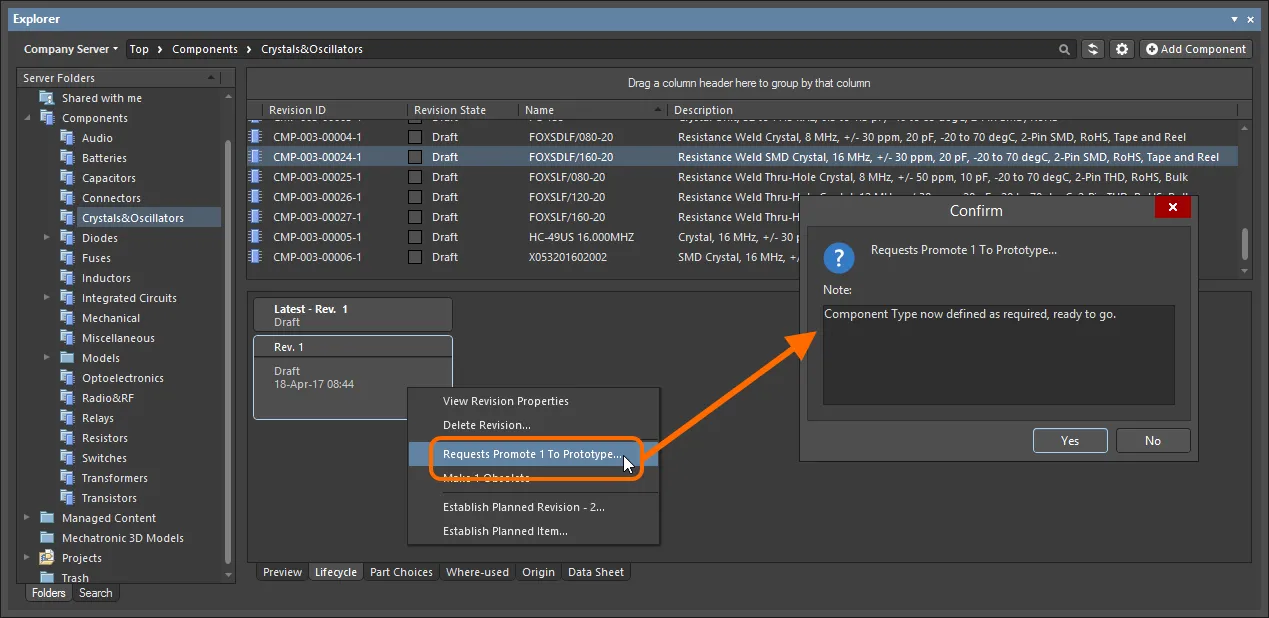
Request the state transition, and add a helpful note to substantiate your case.
Upon creation, members of the applicable approval group for that state transition will receive notification in their message stream, on the Stream page of the server's browser-based interface (and summarized on the Home page of that interface).
Viewing Approval Requests
For both the originator of a state transition request (Requester) and the user(s) defined in the applicable approval group for that state transition (Approvers), pending requests are presented through the Explorer panel using a dedicated Approval Requests folder.
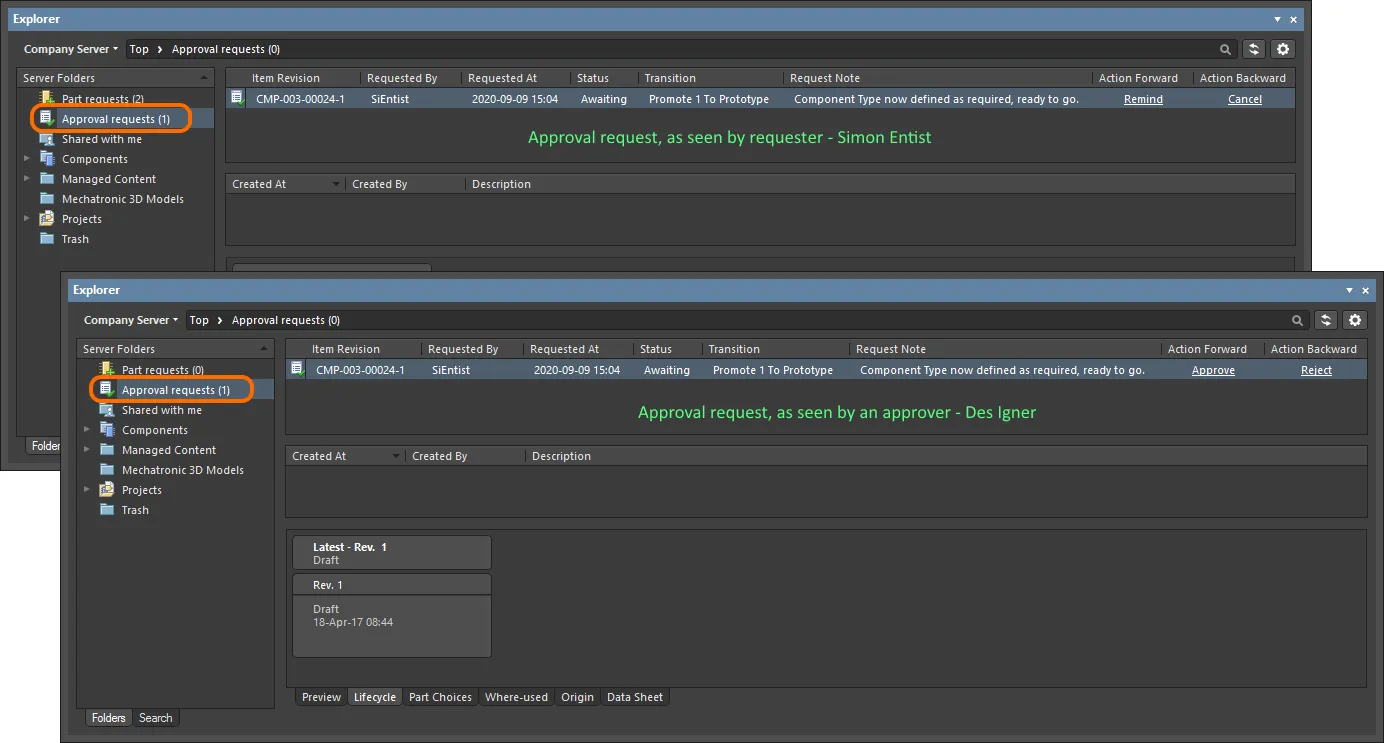
An example Approval Request in the Approval Requests folder, as seen by the requester (Simon Entist) and one of the members of the defined (initial) approval group for the particular state transition (Des Igner).
The number next to the
Approval Requests folder name indicates how many pending requests there are. If the option to
Show Approved Requests is enabled (from the

menu), then this number will reflect the total (pending + approved).
When there are no pending requests, the folder will not be presented. However, if there are approved requests, and the option to Show Approved Requests remains enabled, the folder will remain visible to browse those approved requests. Note that if you disable the Show Approved Requests option, and there are no pending requests, the folder will disappear once again.
The following information is presented for each approval request:
- Item Revision - the specific Item revision for which the request is being made.
- Requested By - the originator of the request (the requester). The entry here takes the user's User Name.
- Requested At - the date and time at which the request was created.
- Status - the current status of the request. This can be one of the following states:
- Awaiting - the request is currently awaiting action by one or more approvers.
- Approved - the request was approved. Note that this state will only be entered upon full, complete approval, by all approval groups defined for that transition.
- Transition - the specific state transition that is being requested for this Item revision.
- Request Note - any note that has been added by the requester, at the time the request was made.
- Action Forward - the controls presented here are only for pending requests (those with a status of Awaiting). Controls differ to cater for the two parties as follows:
- Requester - the user who created the request can Remind it.
- Approvers - a user within an approval group can Approve the request.
- Action Backward - the controls presented here are only for pending requests (those with a status of Awaiting). Controls differ to cater for the two parties as follows:
- Requester - the user who created the request can Cancel it.
- Approvers - a user within an approval group can Reject the request.
Action-based commands for the approval request are also available from the right-click menu for the Item Revision's lifecycle (within the Lifecycle aspect view).
Actioning a Request
As briefly described in the previous section, both requester and approver have actions that they can take. The following collapsible sections take a closer look at each of those actions:
Remind
This action can be taken by the requester if they have been waiting for approval, but have not yet got it. It is analogous to nudging someone, or bumping a forum post - in other words a polite way of reminding those in the applicable approval group that they need to take action (either way). Click the Remind control associated with the approval request. A Confirm dialog appears, in which you can enter a note that perhaps raises the level of urgency for the approval to be made! Click Yes to effect the reminder - members of the applicable approval group for that state transition will receive the reminder in their message stream, on the Stream page of the server's browser-based interface.
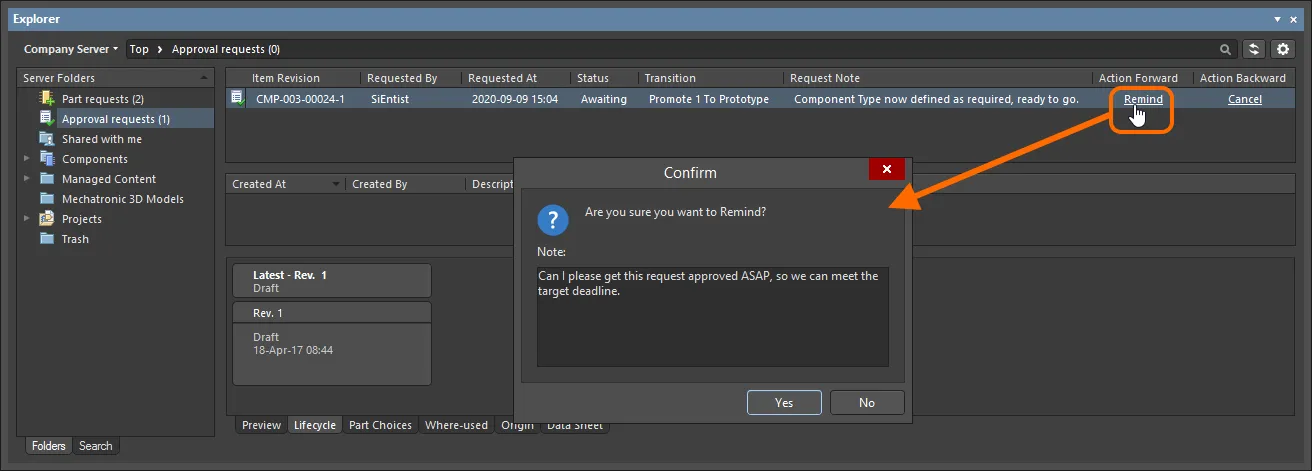
Example use of the Remind action.
Approve
This action can be taken by a member of the applicable approval group, to approve that request. Click the Approve control associated with the approval request. A Confirm dialog appears, in which you can enter a note if required. Click Yes to effect the approval - the requester for that state transition will receive notification in their message stream, on the Stream page of the server's browser-based interface.
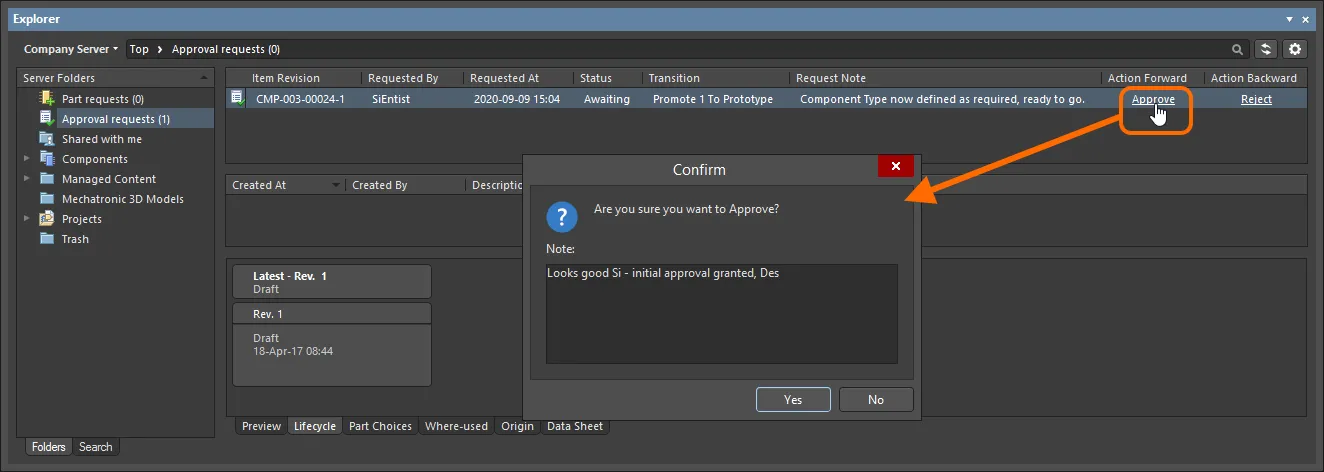
Example use of the Approve action.
If there is only one approval group, approval of the request will result in the state transition occuring automatically. If there are multiple approval groups, then the request will await approval from a member of the next group. If the approver in the first approval group is also a member of the next approval group, approval will be automatic for that second group.
Reject
This action can be taken by a member of an approval group, to reject that request. Click the Reject control associated with the approval request. A Confirm dialog appears, in which you can enter a note if required, perhaps indicative of why the request has been rejected. Click Yes to effect the rejection - the approval request will be deleted, and the requester for that state transition will receive notification in their message stream, on the Stream page of the server's browser-based interface.

Example use of the Reject action.
Cancel
This action can be taken by the requester if they have been waiting for approval, but have since decided to cancel the request. This could happen, for example, if another issue has since been found that would negate the need to transition to the required lifecycle state. Click the Cancel control associated with the approval request. A Confirm dialog appears, in which you can enter a note if required. Click Yes to effect the cancellation - the approval request will be deleted.
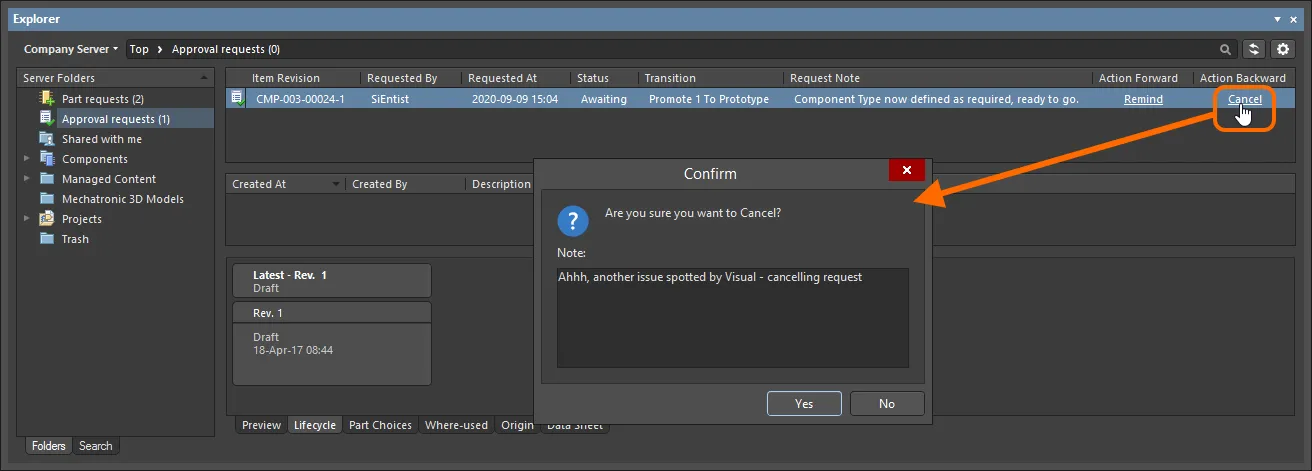
Example use of the Cancel action.
Approval Information Stream
When a request is approved, notification is also available in the central region of the page, when browsing that approval request. This information consists of the following elements:
- Created At - the date and time at which the approval request was approved.
- Created By - the member of the relevant approval group who approved the request. The entry here takes the user's User Name.
- Description - an entry that consists of an auto-generated messsage, along with any note included by the approver, at the time approval was given. The auto-generated part of the description depends on the type of approval:
- Final approval (from a member of the only, or last, approval group) - task approved and completed.
- Intermediate approval (from a member of an approval group that is not the last approval group) - task approved and assigned to next approval group <ApprovalGroupName>.

An example of the approval stream for a particular Item Revision, as seen by the requester. In this case, the transition had to pass through two stages of approval (obtaining approval from a member of two different approval groups).
Such approval information is available only for approval requests that have a status of Approved, or have a status of Awaiting, and have been approved by the first of multiple associated approval groups.
The following people see this information:
- The requester of the state transition.
- The user who gives final approval for the request. So where multiple approval groups are involved, only the member of the final approval group - who gives the final approval - will see this information. A member of an approval group that gives intermediate approval will not see this stream.
